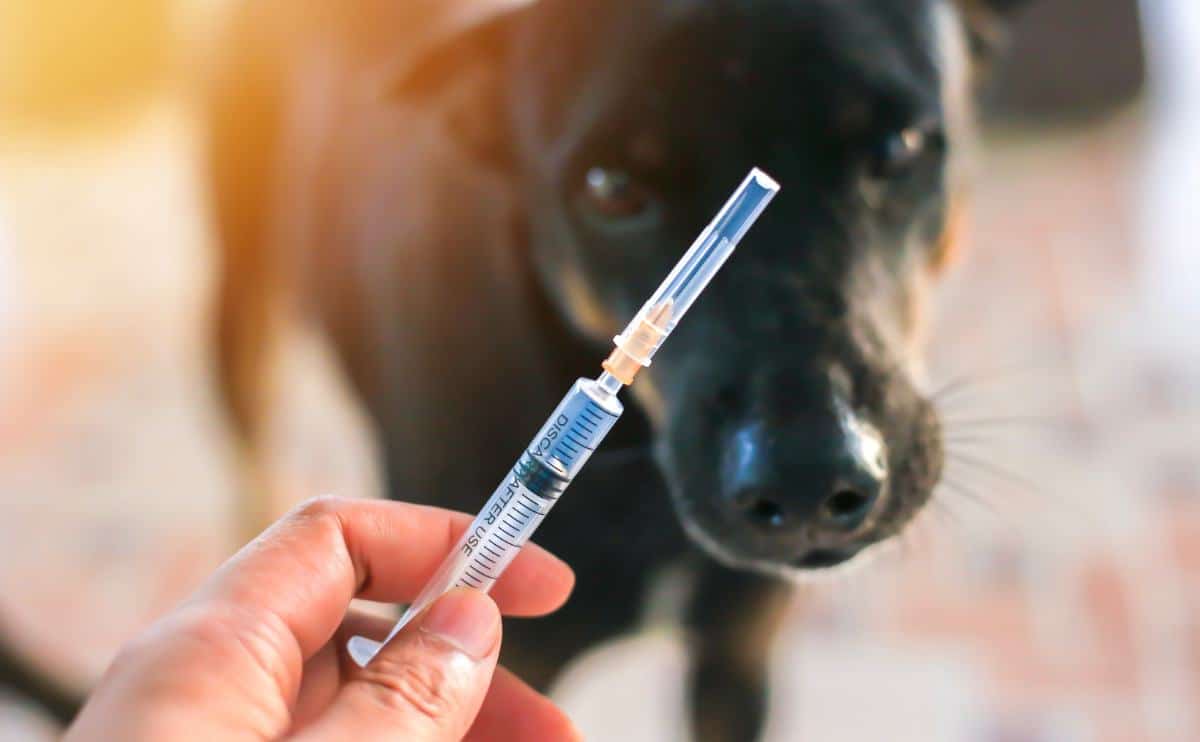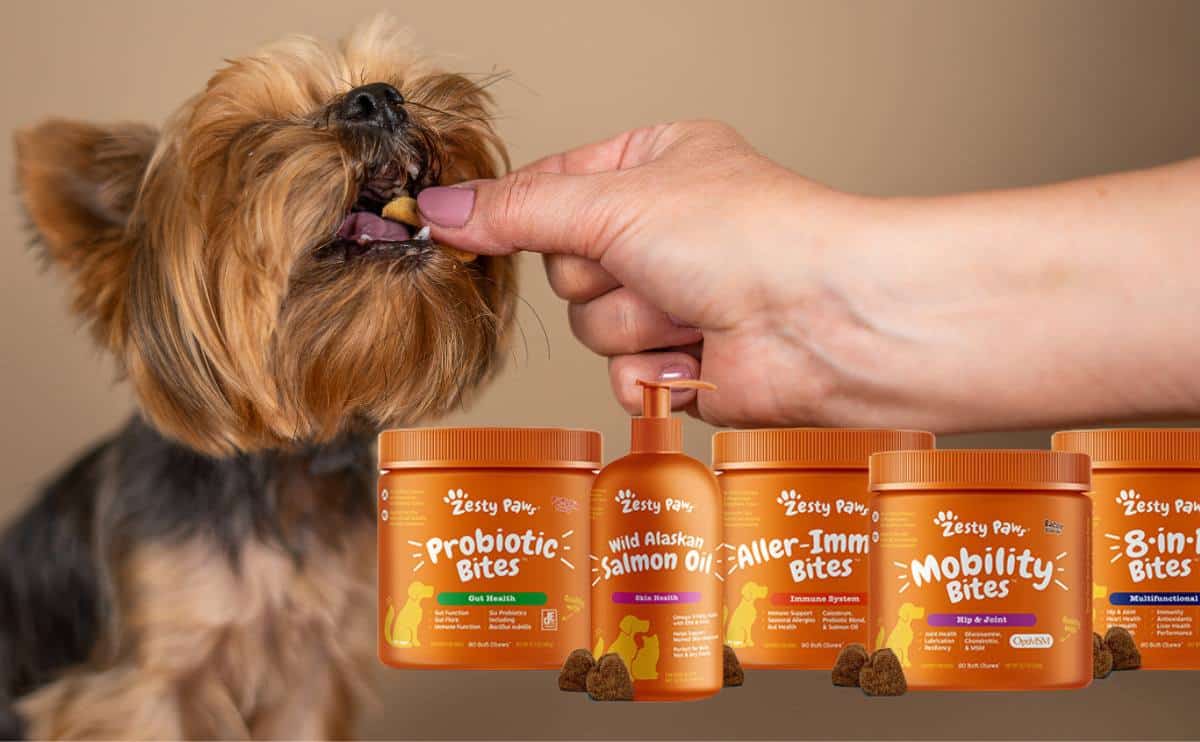Uveitis In Dogs: Cause, Symptoms, Treatment & More
When you purchase through links on our site, we may earn a commission. Here’s how it works.
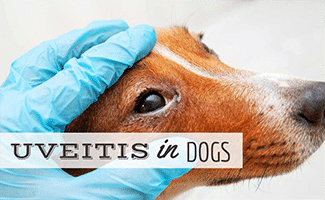
Uveitis is an inflammatory condition of the eye that can happen suddenly in dogs for various reasons. Severe cases of uveitis can affect your dog’s vision and even lead to loss of sight. This article will explore what uveitis is, what might cause it, when to seek veterinary attention, and what treatment options are available.
Table of Contents
What Is Uveitis In Dogs?
Uveitis is defined as an inflammation of the uveal tract of the eye. The uveal tract is essentially the middle section of the eye and is composed of the iris (the colored circle around the pupil), the ciliary body, which produces fluid inside the eye (aqueous humor), and the choroid, which provides nutrition to the back of the eye. Uveitis can be further classified as the inflamed parts of the eye.
- Anterior uveitis in dogs refers to inflammation in the anterior (front) eye section, including the iris and ciliary body.
- Posterior uveitis in dogs refers to inflammation of the choroid and associated blood vessels
Inflammation within the eye causes the normal barrier between the eye and the blood vessels that supply the eye to break down. This allows white blood cells and inflammatory proteins to leak from the blood vessels into the eye and cause inflammation of the uveal tract.
What Can Cause Uveitis In Dogs?
The causes of uveitis are varied and are broadly divided into primary causes (originating within the eye) or secondary causes (originating within the body and secondarily affecting the eye).
Primary causes of uveitis include trauma to the eye, infection, auto-immune disease, cataracts, and tumors or cancer of the eye. Secondary causes of uveitis can involve any body system or illness, including systemic infections (from bacteria, viruses, or parasites), toxins, hormone diseases such as diabetes, cancer, and high blood pressure.
In some cases of uveitis, an underlying cause is not found, and the uveitis is termed ‘idiopathic’ (or ‘without cause’).
What Are The Signs Of Uveitis In Dogs?
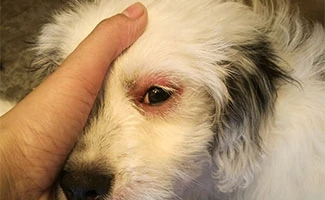
Signs of eye disease in dogs can be very subtle. If you’re concerned that your dog’s eye is painful, looks red or inflamed, or your dog’s vision is affected, then it is advisable to seek urgent veterinary advice. The sooner uveitis is diagnosed, the sooner it can be treated, giving your dog a better chance of fully recovering.
Symptoms of uveitis in dogs may include:
- Squinting or holding the eye closed
- Rubbing at the eye
- Sensitivity to light
- Watery discharge from the eye
- Constricted pupil or asymmetric pupils
- Cloudiness to the front of the eye or a blue tinge to the surface of the eye (cornea)
- “Bloodshot” eye – the white of the eye may look red with engorged blood vessels
- Swelling around the eye
- Third eyelid protrusion
- Change to the color of the iris – the iris may become darker in the affected eye
Some dogs may show signs of systemic illness with uveitis, depending on the underlying cause, and may be depressed, refusing their food, or not as energetic as normal. Uveitis can be a painful condition, although it is hard for our canine friends to show ocular pain. Signs of ocular pain can be subtle such as squinting or closing the eye (also known as ‘blepharospasm’), rubbing the eye, or pressing the side of their head against furniture or objects.
How Is Uveitis Diagnosed?
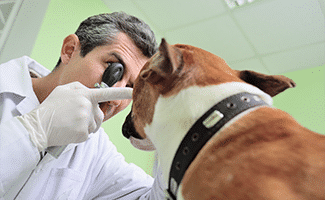
Your vet will diagnose uveitis by performing an ophthalmic examination. This may include looking at your dog’s eyes with an instrument called an ophthalmoscope or a slit lamp which is used to visualize the internal structures of the eye. Sometimes, further examination of the back of the eye is needed using an ultrasound scanner.
Your dog’s vet may need to measure the pressure within the eyeball (intraocular pressure) using a tonometer. There are several different types of tonometers that all work by gently touching the eye’s surface. Most dogs tolerate this quick assessment well (even if the device looks a little scary) after a few drops of a local anesthetic to numb the eye’s surface.
A wider general examination will also be performed to assess your dog’s general health and determine if there are any other underlying causes for the uveitis. A full medical history is useful, including if your dog has traveled abroad, as this may increase the risk of infectious or parasitic diseases. Further tests such as blood tests or scans may be recommended if your vet is concerned there may be a disease or infection outside the eye or if your dog is not responding to initial treatment.
What Does Low Eye Pressure In Dogs Mean?
Low intraocular pressure in dogs can be a sign of uveitis. The inflammation within the eye causes increased outflow of fluid from the eye and a drop in eye pressure. A change in pressure in your dog’s eye can cause pain. Your vet will measure the pressure within the eye using a tonometer and start treatment to reduce ocular pain if the pressure is low.
How Is Uveitis Treated In Dogs?

Uveitis should be treated promptly to prevent long-term damage to the structures within the eye and problems with your dog’s vision.
Treatment of uveitis will depend on the source of the inflammation and any underlying diseases. Eye drops containing anti-inflammatory steroids are often used as part of treatment alongside pain relief and antibiotics when a bacterial infection is suspected of causing uveitis. Atropine may be applied to your dog’s eye as an eye drop to dilate the pupil and reduce pain. Oral medications may be given to reduce inflammation or treat the underlying cause of inflammation, such as anti-parasite medication.
Your dog will need to be monitored closely following a uveitis diagnosis to check their response to treatment and monitor for more serious complications of uveitis within the eye. Uveitis may damage the draining angle of the eye leading to glaucoma (high pressure within the eye), or can damage other structures in the eye leading to corneal ulcers, cataracts, and retinal detachment. It is important to attend any follow-up appointments your vet recommends for your dog after a diagnosis of uveitis so they can assess their response to treatment and screen for these more severe complications.
Natural Treatments For Uveitis In Dogs
Uveitis can be a painful condition in dogs and, if left untreated, can have severe consequences for your dog’s eyesight. Uveitis nearly always needs treatment prescribed by a veterinarian and cannot be managed alone at home.
However, antioxidants found in many vitamins and minerals (such as vitamin A, magnesium, calcium, zinc, and selenium) are effective for eye health and may reduce the symptoms of anterior uveitis. Turmeric also has antioxidant properties and may help boost the immune system. Supplementing your dog’s diet with these compounds may reduce ocular inflammation and help them recover from uveitis faster.
Can Uveitis Be Cured In Dogs?
Uveitis primary ocular disease (problems originating from within the eye), has a greater chance of resolution than uveitis which occurs secondary to other diseases within the body. Systemic causes may require longer treatment and result in recurrence once treatment stops. If the underlying cause is treated or removed, it is possible to resolve uveitis completely and discontinue the medication.
Uveitis In Dogs Prognosis
Uveitis is a serious eye condition in pets and, if left untreated, can lead to blindness. The prognosis depends on the underlying cause of the inflammation. However, with early diagnosis, appropriate treatment, and monitoring the prognosis for dogs with uveitis is usually good.
Uveitis is a common inflammatory condition of the eye that varies hugely in its severity and has a variety of underlying causes that affect the prognosis and response to treatment. Symptoms of uveitis can be vague. Any concerns regarding the appearance of your dog’s eyes or his eyesight should warrant veterinary attention. It is important to follow your veterinarian’s advice regarding treatment and follow-up to help your dog recover from uveitis promptly and avoid more serious complications.
